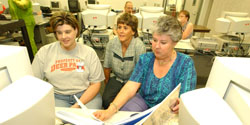

Planning Projects
Teaching and Learning Strategies
Project Planning Guides
| Use these project planning resources to develop a project. Plan a Project Assessment in Projects Portfolio Rubric Project Checklist Project Ideas |
Assessment Planning Resources
| The Assessing Projects resource provides detailed information about the benefits of learner-centred assessment as well as how to use these and other assessment strategies in your classroom. See examples of teacher-created assessment plans that embed assessments throughout several different projects. Read more > |
To teach something well and ensure that learners are engaged in learning, teachers need to plan and prepare effectively. If the goal is for learners to achieve at high levels, then proper planning and preparation are expected no matter what type of teaching is going on. Project-based learning is no exception.
In order to be successful, projects need to be designed with the end in mind. Without closely focused project goals, the purpose of the project can become unclear and expectations for learning outcomes can be miscommunicated. When designing projects, it is important to ensure that the activities planned will help your learners meet the project goals and assessment standards. By reviewing the project goals and assessment standards teachers make choices for establishing curricular priorities. At a very basic level, project planning involves the following steps:
- Determine specific project goals by using assessment standards and the desired higher-order thinking skills
- Develop Curriculum-Aligned Questions
- Make an assessment plan
- Design activities
Misconceptions of Project Approaches
When people hear the phrase, “project-based learning”, different concepts and definitions may come to mind. These may include some of the common misconceptions below.
Project-based learning experiences are long and hard to keep focused.
Projects involve all kinds of ”hands-on” or “minds-on” tasks of varying complexity and length. Tasks can be as detailed and involved as a service-learning project on pollution or as simple as an in-class debate. A project will be focused as long as it is well-planned, aligned to important assessment standards, and clearly states learner expectations. Project duration can vary from an intense 4-6 lessons in class to a lower key 4-6 months, when the learners will not necessarily be working fulltime on the project in class.
Project-based learning means a complete change in teaching and learning practices.
Project-based learning is teaching and learning method in a repertoire of methods. It is not appropriate for the teaching of all skills and knowledge. It incorporates and accounts for varied teaching strategies and learning styles and is a way to build on current teaching and learning to enrich learning experiences and make more efficient use of time. The focus of an educator has not changed. The goal remains to facilitate what learners need to know and need to be able to do. Project-based learning simply provides a new approach to reaching this goal.
Project-based learning means a lot of work.
For some teachers the shift to project-based learning may not encompass many challenges, but for others the idea may be overwhelming. If you are new to projects, it is best to start small and build upon what works well. Starting small means incorporating one or two teaching and learning methods at a time, while building up to the complete design and implementation of a longer term project-based unit. Starting small can mean incorporating:
- Community experts
- A project scenario
- A learner generated rubric
- Cooperative grouping strategies
